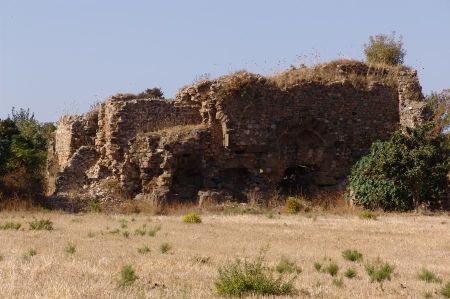The ancient City of Selinus in Gazipasa
The ancient City of Selinus is about 45 km away from Alanya and 2 km from the city center of Gazipaşa (follow the signposts). The road follows the river Musa Çay, once called Selinus too.
At the mouth of the river there is a small stony beach, to the north of it a new fishing harbour and marina. The Kızılin cave is at the northern end of the beach. Muz Beach is on the southern side of Selinus with fine sand and Koru Beach next to it, also called the lava beach, which is suitable for diving. Here millstones used to be cut during the middle ages. At all beaches the water quickly becomes deep.
The town goes back to the 6th century BC, probably founded by the Phoenicians. At least, remains of Phoenician amphorae have been found. According to Herodotus Selinus (which he called Salleme) was a part of the contested border area between Lydia and the Persian Empire during the 6th century BC. There were also settlements in Hellenistic time, the fortress at acropolis and the theatre / odeon contain Hellenistic brickwork. It is also known that it was a hideout for the pirates before their annihilation in 67 BC. The first time Selinus was mentioned by the Romans is known as if from 117 AD when Emperor Trajan died of his wounds on 9th August on his way home from a battle against the Parthenians at the east. The body was cremated and the ashes taken to Rome and interred in the famous Trajan column. The town was now renamed Trajanopolis and was visited by his successor Emperor Hadrian (117-138), who secured financial support from Rome, starting a period of growth. Coins were made with the picture of Emperor Trajan and used up to the time of Alexander Severus (222-235). In 269 the town was plundered by the Persians and later by Isauric mountain tribes in the 5th century. In Byzantine time the town was an episcopal residence. Later the fortress was taken over by the Armenians and in 1221 by the Seljuks, who named the place Selinti.
Good stone steps lead up the mountain, where you can see remains of town wall, houses and churches. There is a cistern on the acropolis at the top plus some indefinable ruins, remains of a late Roman and Byzantine fortress. East of it is a church with an apse. The last few metres to the top and the fine view require some climbing skills. Half an hour it takes to reach the top.
From the mountain you can view the few ruins in the valley. The best preserved is a Seljuk country house, or possibly a caravanserai, decorated with zig-zag figures and built from reused Roman building materials, probably from Trajan’s tomb. This tomb was the centre of a Trajan cult and is inscribed on coins for more than 150 years, proving the town was proud of its deceased Emperor. Excavations show that the Seljuk building was placed on a 800 square metres area surrounded by a colonnade of 110 columns. Closer to the foot of the mountain there is a small theatre or odeon, and the baths with remains of the east-west aqueduct, which crossed the river just before the Seljuk building. Left (east) of the baths by a bend in the river there are the few remains of the town’s square, agora, with a few scattered granite columns. Further east and close to the water there is a bath with two barrel vaulted rooms. The ruins on the plain are on cultivated area, so access to them depends on the time of year and the good will of the owning farmer.
At the necropolis west of the Seljuk building stands a single monumental grave and a grave from the 1st or 2nd centuries AD with an inscription about the Roman centurion (officer) C. Julius Celer, a veteran from a Roman naval force. The Latin text is the only one at the necropolis, which suggests that he and his family were foreigners in the town. All other inscriptions are in Greek.
3 km north east of Selinus and south of Gazipaşa on a top that is difficult to reach there are ruins from a monastery from the Byzantine period. West of it are ruins from a two storey high square barrel vaulted tower.
Please read as well:
Gazipasa - the Banana story on Terraces at the seaside
Syedra - ancient city on the way to Gazipasa
-
-
-
-
-
-
-
-
-
-
-
-
https://www.alaturka.info/en/turkey-country/riviera/1668-selinus-gazipasa-en/amp#sigProIdcfa216c155
